 |
 |
 |
| |
Outcomes of COVID-19 related hospitalisation among people with HIV in the ISARIC WHO Clinical Characterization Protocol (UK): a prospective observational study. HIV Drug Therapy/Glasgow 2020 - HIV Raises COVID Death Risk 52% in 47,573-Person UK Study
|
| |
| |
Download the PDF here
HIV Drug Therapy/Glasgow 2020, October 5-8, 2020
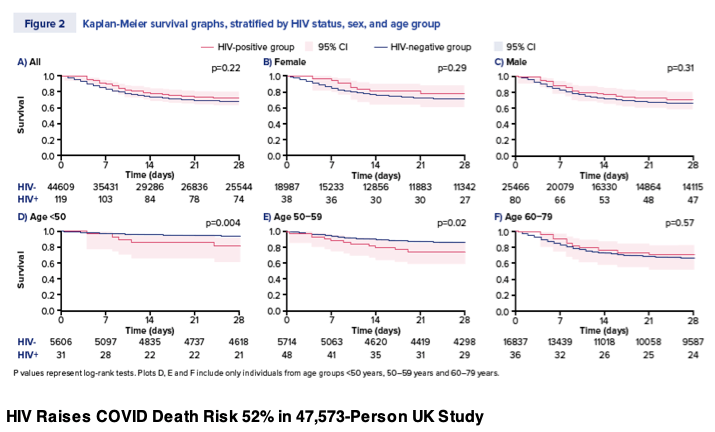
Mark Mascolini
Having HIV infection raised the risk of dying from COVID-19 by 52% in a prospective 47,573-person nationwide analysis in the United Kingdom (UK) [1]. Among people under 70 years old, HIV nearly doubled the risk of dying with COVID-19.
Studies disagree on whether HIV infection worsens risks or outcomes with COVID-19. One international database analysis including 49,763 HIV-negative and 404 HIV-positive people with COVID-19 found that the HIV group had a 55% higher risk of death in 30 days [2]. But that higher risk disappeared after 1-to-1 propensity score matching of the HIV group to a non-HIV group.
The UK study addressed risk of 28-day mortality with COVID-19 among inpatients with versus without HIV infection at 207 centers across the UK. The analysis ran from January 17, 2020 to June 18, 2020. All 47,573 participants had PCR-confirmed SARS-CoV-2 infection or strongly suspected infection. Of the 123 people (0.26%) with confirmed HIV infection, 111 (90%) had an antiretroviral record.
The analysis excluded people who definitely got COVID-19 in the hospital. Researchers used Cox regression to assess the association between HIV status and day-28 mortality after adjustment for age, sex, ethnicity, possible hospital acquisition of COVID-19, presentation date, presence or absence of 10 comorbidities, and hypoxia or oxygen therapy at presentation.
People with HIV were significantly younger than the HIV-negative group (median 56 vs 74 years, P < 0.001). While 62% of people with HIV were between 40 and 59 years old, 19.6% of the non-HIV group fell into that age range. A significantly lower proportion of people with than without HIV was white (44.7% vs 84.2%) and a significantly higher proportion black (42.1% vs 3.5%) (P < 0.001).
Median number of comorbidities was 1 in the HIV group and 2 in the HIV-negative group (P < 0.001). Compared with HIV-negative people, the HIV-positive group had significantly lower proportions with cardiac disease (18.6% vs 32.4%, P = 0.001), pulmonary disease (10.7% vs 17.9%, P= 0.04), dementia (2.5% vs 16.8%, P < 0.001), and malignancy (3.4% vs 10.4%, P = 0.009). But a higher proportion of people with HIV had moderate or severe liver disease (5.0% vs 1.9%, P = 0.02).
Compared with HIV-positive people, those without HIV had COVID-19 for a significantly shorter time (median 3 vs 5 days, P = 0.002), lower diastolic blood pressure (median 74 vs 80 mm Hg, P = 0.009), and lower proportions with systemic COVID-19 symptoms (68.5% vs 88.5%, P < 0.001), fever at or above 37.8 C (36.2% vs 50.9%, P = 0.001), or tachycardia (33.2% vs 44.1%, P = 0.01). People with HIV had a significantly lower white cell count (median 6.6 vs 7.4, P = 0.01) and significantly higher C-reactive protein, an inflammation marker (median 107 vs 83, P = 0.02).
Through 28 days, 31 people with HIV (25.2%) and 13,963 without HIV (29.4%) died. Kaplan-Meier survival analysis showed no significant mortality difference between people with versus without HIV, even when the researchers stratified the analysis by sex. But stratification by age showed significantly greater mortality in COVID-19 patients with than without HIV who were younger than 50 (P = 0.004) and in those 50 to 59 years old (P = 0.02). The mortality difference between COVID-19 patients with versus without HIV did not hold in people 60 to 79 years old (P = 0.57).
In the unadjusted Cox model, people with HIV did not have a higher risk of death with COVID-19. But a model adjusted for age determined that HIV-positive people had more than a 50% higher risk of dying with COVID-19 (hazard ratio [HR] 1.52, 95% confidence interval [CI] 1.05 to 2.20, P = 0.03). The higher death risk with HIV was similar in a model adjusted for age and sex (HR 1.50, 95% CI 1.03 to 2.18, P = 0.03). The model with the most adjustments (for sex, ethnicity, age, presentation date, possible hospital-acquired COVID-19, 10 comorbidities, hypoxia/oxygen at presentation, in people younger than 70) figured that HIV infection almost doubled the risk of death with COVID-19 (HR 1.92, 95% CI 1.22 to 3.00, P = 0.004).
Comparing the 31 HIV-positive people who died with the 92 HIV-positive people alive at hospital discharge pinpointed four independent death predictors:
Higher risk of death:
Every additional year of age: univariate HR 1.05, 95% CI 1.01 to 1.08, P = 0.006
Diabetes: univariate HR 2.22, 95% CI 1.06 to 4.63, P = 0.03
Obesity: univariate HR 2.73, 95% CI 1.22 to 6.15, P = 0.02
Lower risk of death:
Antiretroviral treatment recorded: univariate HR 0.38, 95% CI 0.15 to 0.92, P = 0.03
The researchers underlined the importance of early HIV diagnosis and prompt antiretroviral therapy, optimized screening for and control of comorbidities (including obesity and diabetes), and recording HIV status upon hospital admission for COVID-19.
References
1. Geretti A, Stockdale A, Kelly S, et al. Outcomes of COVID-19 related hospitalisation among people with HIV in the ISARIC WHO Clinical Characterization Protocol (UK): a prospective observational study. HIV Drug Therapy/Glasgow 2020, October 5-8, 2020. Abstract O422.
2. Hadi YB, Syeda I, Naqvi FZ, Kupec JT, Sarwari AR. Characteristics and outcomes of COVID-19 in patients with HIV: a multicentre research network study. AIDS. 2020;34:F3-F8. doi: 10.1097/QAD.0000000000002666.
attached is poster pdf

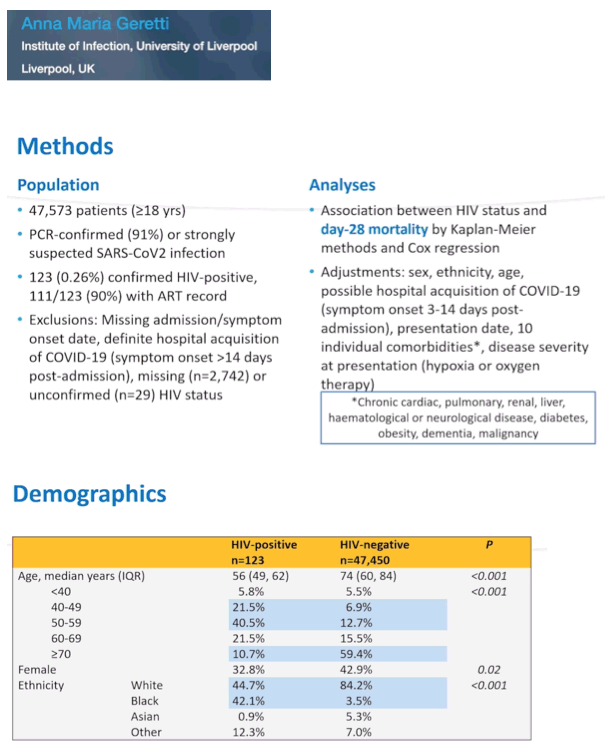
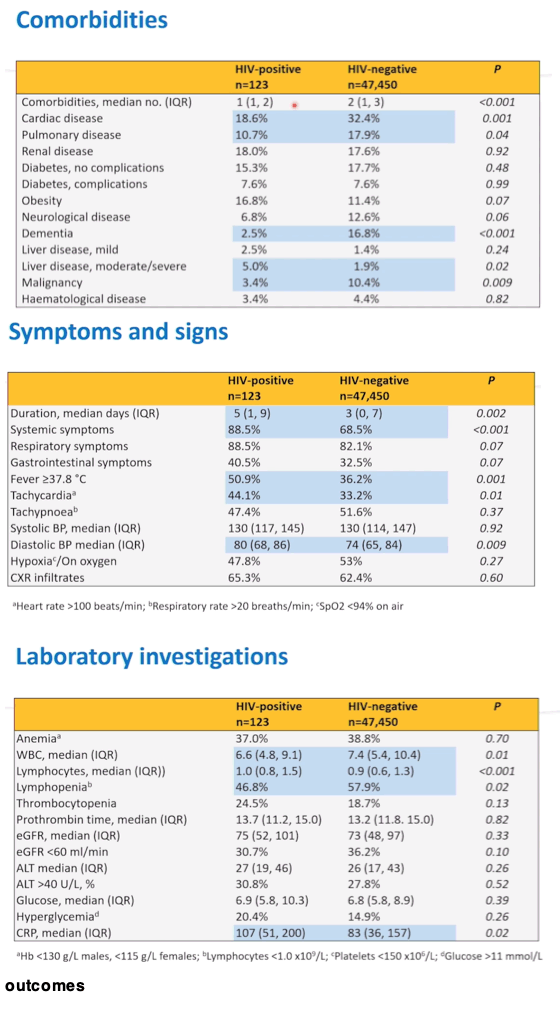
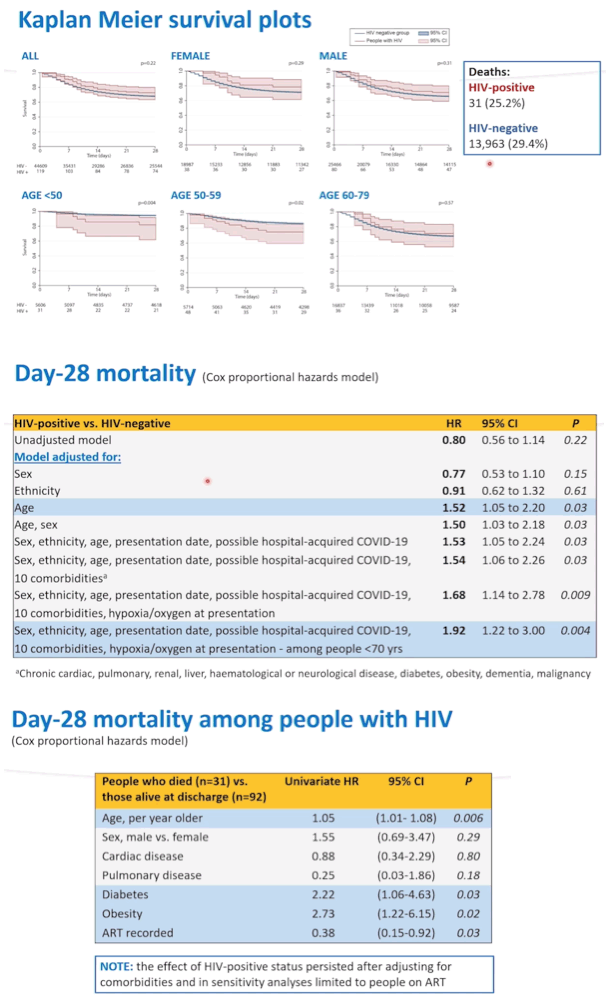
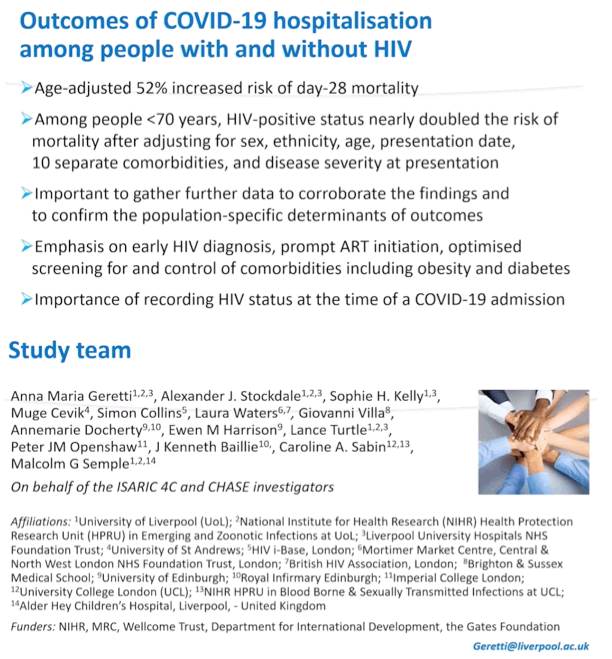
|
| |
|
 |
 |
|
|